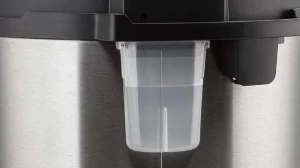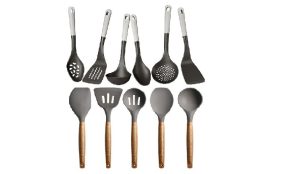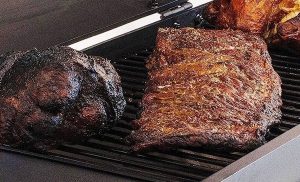4 Best Steam Canners Reviewed for 2025
Note: This article may contain affiliate links, which means if you make a purchase following our links won’t cost you extra, but we may earn a commission. Learn more
Choosing the best steam canner involves considering several factors to ensure safety, efficiency, and ease of use. Steam canners are designed to preserve foods using steam’s heat, offering a quicker alternative to traditional water bath canning methods.
They work by heating water to produce steam, which then circulates inside the canner to process food jars. This method is suitable for high-acid foods and recipes that require 45 minutes or less of processing time, adjusting for altitude when necessary.
Steam canners are safe when used according to specific instructions, including proper heating and timing. They stand out for their convenience, using less water and heating up more quickly than water bath canners.
- Best Choice: Kitchen Crop Steam Canner

However, it’s vital to follow steam canning instructions closely, such as preheating the canner and jars and ensuring correct processing times, to ensure food safety.
Steam canning can be a great choice for those looking for an efficient and effective way to preserve their harvest, offering a simpler setup and quicker processing times compared to traditional methods.
# Kitchen Crop Steam Canner
The Kitchen Crop Steam Canner revolutionizes home canning, making it accessible and more efficient than ever. This aluminum canner, with its innovative design, features a patent-pending temperature indicator on the lid, eliminating the guesswork from the canning process.
Its construction allows for faster heat-up times, cutting preheating in half compared to traditional water bath canning methods. Capable of processing up to 7 quart or 8-pint jars at once, it is designed for high-acid foods, ensuring a large capacity without the need for half-gallon jars.
The lightweight design, combined with cool-touch silicone handles and a significant reduction in water use (80% less than traditional methods), makes it a standout choice for both beginners and experienced canners seeking convenience and safety.
- Special Feature: Patent Pending Temperature Indicator
- Capacity: Up to 7 quart or 8 pint jars
- Material: Aluminum
- Dimensions: 13 x 16.5 x 11 inches
- Weight: 4.2 pounds

Why Best
- No guesswork timing with the temperature indicator
- Quick heat-up time for faster processing
- Lightweight with cool-touch handles
- Uses 80% less water than traditional canning
- Easy and safe to use
Compatible For
- High-acid foods
- Glass top stoves
Where Need to Improve
- Not suitable for half-gallon jars
This Kitchen Crop Steam Canner is perfect for those looking to streamline their canning process. Its innovative features make it efficient and easy to use, ensuring that even beginners can achieve perfect results. Whether you’re preserving jams, jellies, or fruits, this canner is designed to simplify your experience while maximizing safety and efficiency.
# HOMKULA Water Bath Canning Pot
The HOMKULA Water Bath Canning Pot is a comprehensive solution for home canning enthusiasts. This stainless steel, 20-quart canning pot comes with a complete starter kit, including a large folding rack, a collapsible funnel, and various tools designed to make canning a breeze.
Suitable for beginners, this set supports a wide range of canning tasks from jams to pickles. Its thickened metal construction and flat bottom ensure even heat distribution, making it compatible with both gas and glass top stoves.
The pot and tools are crafted from food-grade materials, ensuring safety and durability. Its easy-to-clean design, combined with the convenience of dishwasher-safe components, makes it a practical addition to any kitchen.
Designed for versatility, this canning pot facilitates the preservation of nutrients and flavors in your home-canned goods, providing year-round enjoyment.
- Special Feature: All-in-one canning kits set
- Capacity: 20 Quarts
- Material: Stainless Steel and PP
- Dimensions: 10.6″D x 15″W x 14″H
- Weight: 6.27 pounds

Why Best
- Complete starter kit for beginners
- Compatible with gas and glass top stoves
- Made of food-safe, premium materials
- Easy to clean and store
- Wide application for various canning needs
Compatible For
- Gas stoves
- Glass top stoves
- Dishwasher-safe cleaning
Where Need to Improve
- Bulkier setup for smaller kitchens
The HOMKULA Water Bath Canning Pot with its comprehensive kit is perfect for anyone looking to start their canning journey. It combines quality, safety, and versatility, making it an invaluable tool for preserving a variety of foods. With its ease of use and compatibility with different stove types, this pot ensures that canning is accessible to everyone, from novices to seasoned canners.
# Barton 22-Quart Pressure Canner
The Barton 22-quart Pressure Canner, crafted by XtremepowerUS, serves as a dual-purpose kitchen essential, proficient in both pressure canning and boiling water canning.
Designed for the modern home canner, this polished aluminum pressure canner boasts a generous 22-quart capacity, accommodating a wide array of canning needs from vegetables and meats to jams and salsas.
Its deluxe pressure dial gauge ensures precise processing pressures, vital for high altitude canning, complemented by a spring safety device and a sure-locking lid system for unparalleled safety.
The heavy gauge, rustproof polished aluminum construction coupled with induction compatibility makes it a versatile addition to any kitchen setup, ensuring time and cost efficiency.
- Special Feature: Locking Lid, Induction Compatible Base
- Capacity: 22 Quarts
- Material: Polished Aluminum
- Dimensions: 14″D x 19″W x 14.25″H
- Weight: 13.2 Pounds

Why Best
- Deluxe pressure dial gauge for precision
- Dual-purpose: pressure and water bath canning
- Safety features: spring device and locking lid
- Induction-compatible, versatile kitchen use
- Heavy gauge aluminum for durability
Compatible For
- Gas, electric, induction cooktops
- High altitude canning
Where Need to Improve
- Heavy, challenging to move when full
The Barton 22-Quart Pressure Canner is the perfect tool for those looking to expand their home canning capabilities. With its dual functionality and safety features, it offers a reliable and efficient way to preserve a variety of foods, making it a must-have for both novice and experienced canners.
# Concord Stainless Steel Turbo Steam Canner
The Concord Stainless Steel Turbo Steam Canner is a testament to innovation in home canning, providing an efficient and user-friendly option for preserving your favorite foods.
This 20-quart steamer set, crafted from durable stainless steel, comes complete with a rack, tray, and seven glass quart mason jars, offering everything needed to get started.
Its extra tall lid and triply bottom ensure even steam distribution, while the silicone-wrapped handles protect from heat. The sturdy 3 mm thick rack securely holds jars during the canning process, making it superior to competitors.
Designed for convenience, this set is dishwasher safe, simplifying cleanup.
- Special Feature: Includes canning rack and mason jars, dishwasher safe
- Capacity: 20 Quarts
- Material: Stainless Steel
- Dimensions: 12.6 inch X 12.3 inch
- Weight: 16.17 pounds

Why Best
- Complete set for steam canning
- Triply bottom for even heat distribution
- Dishwasher safe for easy cleanup
- Silicone handles for safety
- Extra thick rack for jar stability
Compatible For
- Induction cooktops
- Large batch canning
Where Need to Improve
- Initial investment is higher than basic models
- Size may be cumbersome for small kitchens
The Concord Turbo Steam Canner is an excellent choice for those who value efficiency, safety, and versatility in their canning endeavors. With its comprehensive set and induction compatibility, it stands out as a top choice for preserving a wide range of foods, making canning more accessible and enjoyable.
Buying Guide: Selecting the Premier Steam Canners
In our quest to identify the best steam canners on the market, we meticulously combined industry insights, user feedback, and hands-on testing to ensure our recommendations stand out for their quality, performance, and reliability. Our selection process is rooted in a systematic approach designed to offer you top-tier products that cater to a variety of canning needs.
Market Research
Our initial step involved extensive market research to pinpoint the latest and most innovative steam canners available. We focused on identifying products that boasted modern features such as efficient heat distribution, compatibility with various stove types, and environmentally friendly water usage. This phase allowed us to gather a diverse pool of products, each promising to revolutionize home canning.
Customer Review Analysis
We then sifted through thousands of customer reviews across multiple platforms. This step was crucial in understanding the real-world performance of each canner, as well as their durability and ease of use from a user’s perspective. Reviews helped highlight products that consistently met or exceeded expectations, ensuring our selections were backed by a community of satisfied users.
Hands-on Tests
To further refine our selections, we conducted hands-on tests to assess the functionality of each steam canner. Criteria such as speed of heating, ease of lid sealing, and accuracy of temperature gauges were evaluated. We also examined how well each canner handled different jar sizes and types of food. This practical evaluation ensured that our recommended products not only boasted impressive features on paper but also excelled in real kitchen environments.
Compatibility and Versatility
Acknowledging the variety of kitchen setups and canning requirements, we prioritized steam canners that showed a high degree of compatibility with different heat sources and versatility in canning various foods. Products that could efficiently process a wide range of preserves, from fruits to meats, while being suitable for use on gas, electric, and induction cooktops, scored higher on our list.
Are Steam Canners Safe?
Concerns about safety are paramount when preserving food at home. Steam canners have been scrutinized for their safety, leading to a consensus among experts that they are indeed safe when used as directed.
These devices, designed to use steam for heat processing, effectively kill bacteria and seal jars to prevent spoilage. Key to their safety is adherence to guidelines specific to steam canning, including proper use of the equipment and following recipes designed for steam canning.
Modern steam canners come equipped with features such as vent ports to ensure proper steam circulation and temperature indicators to guide users in achieving the correct processing environment.
By following the manufacturer’s instructions and using steam canners for appropriate foods (high-acid fruits, jams, jellies, and pickles), users can confidently and safely preserve their harvest.
How Steam Canners Work?
Understanding the operation of steam canners reveals their efficiency and simplicity. These devices use a shallow water bath to generate steam, which then circulates inside the sealed canner to process the food in jars.
The process begins by heating water in the base of the canner until it produces steam. The jars, filled with food and properly sealed, are placed on a rack above the water level. As the steam builds, it envelops the jars, transferring heat to their contents.
This method ensures even heat distribution, crucial for safely preserving food. The design of steam canners allows for faster heating and cooling times compared to water bath canning, making the process more energy-efficient.
How to Use a Steam Canner Properly?
Using a steam canner properly involves a series of steps that ensure the safety and effectiveness of the canning process. This method is particularly suited for high-acid foods such as fruits, pickles, jams, jellies, and salsa. Before beginning, ensure you have a steam canner, jars with lids and bands, a jar lifter, and a canning funnel.
Prepare the Canner and Jars
Step 1: Clean the canner, jars, lids, and bands with warm, soapy water. Rinse thoroughly.
Step 2: Fill the base of the steam canner with the required amount of water as indicated by the manufacturer’s instructions. This is typically 2 to 3 inches of water.
Step 3: Place the canner on the stove over medium heat to warm the water while preparing the jars.
Fill the Jars
Step 1: Prepare your food according to your chosen recipe. Keep the food hot if it is meant to be canned hot.
Step 2: Fill the jars with food using a canning funnel, leaving the appropriate headspace as recommended by the recipe.
Step 3: Wipe the rim of each jar with a clean, damp cloth to remove any food particles that might prevent sealing.
Step 4: Apply the lids and screw on the bands until they are fingertip tight.
Process the Jars
Step 1: Place the jars on the rack inside the steam canner. Ensure the jars do not touch each other to allow for proper steam circulation.
Step 2: Cover the canner with its lid. Turn the heat to high and wait for steam to start venting from the vent hole or for the canner to indicate it has reached the correct temperature.
Step 3: Start your processing time as soon as the canner has vented a steady stream of steam for 10 minutes or reached the indicated temperature for your altitude.
Step 4: Process the jars for the time specified in your recipe, adjusting for altitude if necessary.
Cool Down
Step 1: Once the processing time is complete, turn off the heat and let the canner cool down naturally for 5 minutes before removing the lid.
Step 2: Remove the lid by lifting it away from you to avoid steam burns.
Step 3: Use a jar lifter to carefully remove the jars from the canner. Place them on a towel or cooling rack, ensuring they are not in a drafty area.
Check Seals and Store
Step 1: After 12 to 24 hours, check that the jars have sealed properly by pressing down on the center of each lid. If the lid does not pop back, the jar is sealed.
Step 2: Remove the bands, clean the jars, label them with the contents and date, and store them in a cool, dark place.
Steam Canner Processing Times
Processing times in steam canning are critical to ensure food safety. These times vary depending on the type of food being canned, its acidity, the size of the jars, and altitude.
Steam canners typically require less time to reach the correct temperature compared to water bath canners, due to their efficient heat transfer. However, it is vital to follow the recommended processing times provided by reliable recipes and adjust for altitude as necessary.
This precision ensures that the food is processed long enough to eliminate harmful bacteria without compromising the food’s texture and nutritional value.
Steam Canning Vs Water Bath
Comparing steam canning to water bath canning highlights several advantages and considerations. Steam canners use less water, heat up more quickly, and cool down faster, offering a more energy-efficient option.
They are ideal for high-acid foods and are easier to handle due to their lighter weight and reduced water volume. Water bath canning, on the other hand, is a time-tested method with a broader range of applications, including low-acid foods when acidified properly.
Each method has its specific use cases, with steam canning standing out for its convenience and efficiency in processing high-acid foods.
Pressure Canner Vs Steam Canner
Pressure canners and steam canners serve different purposes in home canning. Pressure canners are designed for low-acid foods, using high pressure to achieve temperatures above boiling point, essential for safely canning vegetables, meats, and fish.
Steam canners, conversely, are suitable for high-acid foods and operate at standard boiling temperatures. The choice between the two depends on the type of food being preserved.
For high-acid foods, steam canners offer a quick and efficient method, whereas pressure canners are necessary for canning low-acid foods safely.
Steam Canning Instructions
To ensure success and safety in steam canning, following specific instructions is crucial. Begin with clean, sterilized jars and ensure the canner is correctly assembled before use.
Fill the base with the recommended amount of water and preheat until steam forms. Load the canner with jars, ensuring they do not touch, and replace the lid to form a tight seal. Process the jars for the recommended time, adjusting for altitude.
After processing, turn off the heat and allow the canner to cool before removing the jars. Following these steps helps preserve food safely and effectively.
Steam Canner Recipes
Classic Strawberry Jam: A favorite for its bright flavor and simple ingredients. Strawberries, sugar, and lemon juice combine to create a spread perfect for morning toast.
Apple Sauce: Utilize autumn’s bounty with this smooth or chunky treat. Apples, water, and a dash of cinnamon offer a homemade comfort food staple.
Tomato Salsa: Capture the essence of summer with tomatoes, onions, peppers, and spices. This recipe adds zest to dishes year-round.
Pickled Cucumbers: Crisp and tangy, these are made with cucumbers, vinegar, and dill. They’re a crunchy addition to any meal.
Peach Preserves: Sweet and luscious, peaches simmered with sugar preserve the taste of summer. Ideal for desserts or as a yogurt topping.
Each recipe embodies the versatility of steam canning, offering delicious ways to enjoy preserved foods throughout the year.
Some Common Questions About Steam Canners
Can You Use a Steam Canner for Low-Acid Foods?
Using a steam canner for low-acid foods is not recommended due to safety concerns. Low-acid foods, such as vegetables, meats, and poultry, require processing at temperatures higher than what steam canners can provide. Pressure canning is the only recommended method for these types of foods because it can reach the necessary temperatures to kill harmful bacteria like Clostridium botulinum, which can cause botulism. Always follow safe canning practices and guidelines provided by trusted sources like the USDA when preserving foods.
How Long Do Foods Last Once Canned Using a Steam Canner?
Foods canned using a steam canner, when done correctly, typically have a shelf life of one year for optimal quality. However, they can remain safe to eat beyond this period if the seal has not been compromised. Store canned goods in a cool, dark place to maximize their shelf life. It’s crucial to inspect jars before consumption for signs of spoilage such as leaking, bulging lids, or off odors, regardless of the canning method used.
Can You Use Glass Top Stoves with Steam Canners?
Yes, you can use steam canners on glass top stoves, but with caution. It’s important to consult both the canner’s manufacturer and the stove’s manual beforehand. Some manufacturers design steam canners to be lightweight and compatible with glass top stoves. However, the size and weight of the canner, filled with jars and water, might exceed the stove manufacturer’s recommendations. Always ensure the canner is not larger than the burner to prevent damage to your stove.
What’s the Difference Between Steam Canning and Pressure Canning?
The primary difference between steam canning and pressure canning lies in the method of heat application and the types of food each method is suitable for. Steam canning uses steam in an enclosed space to process high-acid foods at temperatures of 212°F, similar to boiling water canning but more efficient. Pressure canning, on the other hand, uses pressurized steam to reach higher temperatures (240°F or above), necessary for safely canning low-acid foods like meats and vegetables. The choice between the two methods depends on the type of food being canned.
Are There Any Foods That Shouldn’t Be Canned Using a Steam Canner?
Yes, certain foods shouldn’t be canned using a steam canner. This includes low-acid foods such as meats, poultry, seafood, and most vegetables (except for those acidified with vinegar or lemon juice). These foods require higher temperatures achieved through pressure canning to ensure safety by eliminating the risk of botulism. High-acid foods such as fruits, pickles, jams, jellies, and acidified tomatoes are suitable for steam canning. Always adhere to recipes and guidelines tested and approved for steam canning to ensure food safety.





